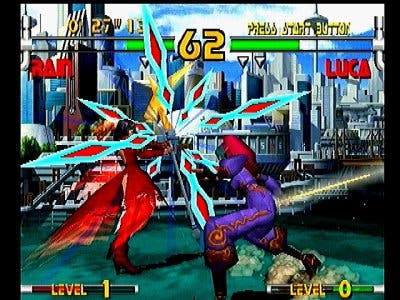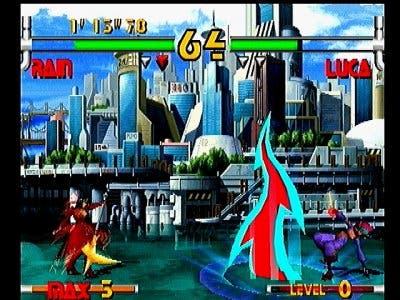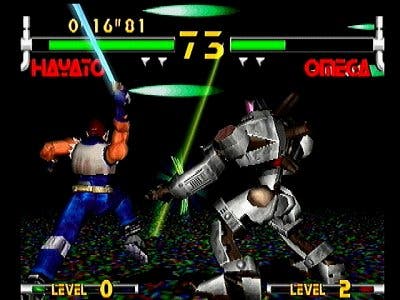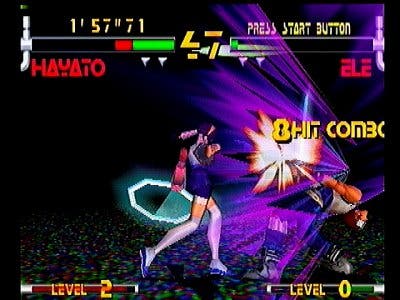Plasma Sword
Review - Star Gladiator for the Dreamcast? Apparently not quite as good an idea as it seemed..

Gladiator Ready!
Hardcore beat-em-up fans aside, few games players in Europe will be familiar with Star Gladiator. Probably the least famous fighting game to come from the Capcom studios, the original was one of the companys abortive forays into 3D beat'em'up territory during the PlayStation era, and was a complete flop outside of Japan. Indeed, it didn't sell particularly well in Japan either by all accounts; the only aspect of the game to achieve any kind of popularity was the central character, Hayato, a sword-wielding young chap with a metal plate riveted to his forehead and a torn vest. Hayato can be found in many of the "Capcom Versus" games (including the recent and rather wonderful Marvel Vs. Capcom 2 on the Dreamcast) and there was talk at one point about a spinoff anime television series featuring the character, although whether this ever came to anything is unknown. It is possibly in order to promote this potentially valuable franchise that Capcom have decided to return to Star Gladiator on the Dreamcast - although, perhaps mindful of the low regard in which the original Star Gladiator is held, Star Gladiator Chapter II has been renamed to "Plasma Sword". Like most modern beat-em-up games, the plot is tenuous to say the least; essentially, the action is all set in a Star Wars-esque universe, which is threatened by a terrible evil which was defeated in the first game but has conveniently reawakened in order to provide an excuse for a sequel. This evil seems to rotate around a chap with a ridiculous hat and a bizarre robot that wouldn't be out of place in an episode of Buck Rogers; how exactly the galaxy is threatened by this pair of jokers is never quite revealed, but we can assume that they are evil beacuse they're collectively referred to as the "Nightmare of Bilstein", so they can't be very pleasant people. In order to save the galaxy from this unspeakably evil person with poor taste in headwear, a band of heroes need to fight against each other in an apparently random fashion. I use "band of heroes" loosely here, because it's never made particularly clear which characters are heroes and which are villains; Hayato is clearly a hero since he rides a motorbike very fast in the intro, thus marking him down as a Good Guy, but aside from that the characters are a motley crew of furry Chewbacca lookalikes, birdmen, and green cone-headed creatures who wear far too much cheap jewellery.

Trick Deck
I'm not really sure why beat-em-up developers even bother trying to create a plot any more; Soul Calibur may have had quite an interesting plot that built up the more you played the game, and Street Fighter and King of the Fighters may have built up great chronologies and backstories over the years, but these are exceptions rather than the rule. The overall effect of Capcom's attempts to make the characters in Plasma Sword unique, to give the game a serious backstory no less, is not as they may have desired. Rather than adding additional depth to the game, it makes makes the whole thing seem cheesier than the most luxurious Quattro Formaggio pizza you've ever seen. (That's quite a claim, milladio -Ed) Every beat-em-up game has joke characters which you can unlock, or a specific character who is meant to provide light relief; be it the Panda in Tekken 3, or Maxi in Soul Calibur (who manages to knock himself out with his nanchaku during a particularly spectacular bit of showing off). One of the basic problems with Plasma Sword is that every single character in the game feels like one of these joke characters; the type of character who, like the playable piece of tofu in Resident Evil 2, is laughed at briefly before being dumped for good, never again to leave the prison-like confines of the character select screen. Only Hayato plays like a reasonably competent fighting character, and even that is at the expense of having any particularly decent special moves. Take, for example, Saturn - a "loveable" green-skinned character who has a cone-shaped head and a lot of multicoloured bangles. He fights using, believe it or not, a pair of yo-yos! Ho ho, isn't this amusing! He hits you with his yo-yos, and even uses them as an impromptu grappling hook! One of his special moves makes you do a little dance before he blats you! As you can imagine, the indescribable hilarity of this wears off very quickly as you realise that not only is Saturn a main character in the game, he is actually relatively normal as Plasma Sword characters go. Others sport laser rifle, light sabers and plasma-edged axes, and all of the characters have ludicrous special moves. As character selections go, playing Plasma Sword for any length of time feels like accidentally picking up a trick deck of cards - one in which every card is a joker.

Count those Polygons!
Poor fight mechanics are unforgiveable in a beat-em-up, and there's no doubt that Plasma Sword has some of the poorest fight mechanics I've ever seen, making the likes of the risible Star Wars: Masters of Teras Kasi look enjoyable and deep. In fact, the fighting system in Plasma Sword makes Kate Moss' lingerie look deep. Frankly, it's appalling that a company like Capcom can on one hand produce wonderful beat'em'ups such as Marvel Vs Capcom 2 and SNK Vs Capcom, and yet turn around and produce low-grade dross such as this at the same time. Some of the poor gameplay could be excused if the game was a graphical triumph, but sadly this is less of a triumph and more of a full-scale disaster. The graphics of Plasma Sword are not only clunky and outdated by Dreamcast standards (after all, with technically stunning games such as Soul Calibur and Dead Or Alive 2 on the system, it's becoming increasingly difficult to look ground-breakingly stunning on the Dreamcast), but they would look poor on a modern PlayStation game. Not exactly high praise for a title running on the fastest currently-available console system! (Over here anyway, tomorrow is the 26th of October lest we forget -Ed) The characters themselves are very low-polygon - they look chunky and blocky, and shading artifacts mean that the edges of the polygons are easy to see. The low-quality textures used don't do anything but exacerbate this and the poor-quality animation of the characters doesn't help much either. Character movement looks jerky and I suspect that the game doesn't bother to use tweening frames in animations, or that their tweening system simply doesn't work. Either way, the characters look terrible when they stand still, and even worse when they move. So where, you may ask, is the processor power of your Sega-built superconsole going? It isn't the game mechanics, it certainly isn't the character graphics, could it be that the play areas are breathtakingly lush and detailed?

I'm on a Plane
Whatever your Dreamcast's power is doing while playing Plasma Sword (I would imagine that "not a lot" pretty much summarises the answer to this question, actually), it isn't being pumped into displaying lush backgrounds. The backgrounds are, in fact - wait for it - 2D images that scroll around as you fight. Yes, good old hand-drawn 2D. The ground on which you fight is similar to Dead Or Alive on the Playstation - a rectangle that mysteriously fades into the distance about 3 metres away from your feet. Somebody on the development team must have been drinking a lot of coffee while creating some of the stages, however, because they have completely outdone themselves by having the characters fight in a giant puddle - with ripples and reflections! Actually, what this boils down to is that two small circles appear beside your characters feet every time they step anywhere, and the buildings in the background are mirrored into the water with a slightly wavy modifier applied to them. This has the presumably unwanted effect of making it look as though your characters are doing battle on a stretched piece of cling film suspended over a futuristic city; however, this is about as special as the "special" effects in Plasma Sword get. After all, when other graphical highlights include "pasting a random texture all over the floor during special moves" (I call this the "vomit in a compost heap" effect) and "a slowly expanding circle with multicoloured bits", one does start to wonder about the use of the word "highlight" in the first place. As far as aural stimulation goes, Plasma Sword is not actually substandard; it is just very, very average. The music consists of endless looped samples that sound like, well, every single other beat-em-up game you ever played. There are "thunk" noises when you kick somebody and "thwap" noises when you slap them with your weapon, as well as "grunt" and "argh" noises when something particularly painful happens to a character onscreen. One of the few positive things to be said about the game is that the Japanese voices have not been redubbed for the Western release. The addition of terrible American voiceovers would have been a final dash of awkwardness which would probably have reduced this reviewer to tears of pain and desperation. As it stands, the voiceovers, like the rest of the audio in the game, is completely unremarkable.
Conclusion
The Dreamcast is a wonderful console. It is powerful, well-supported, reliable and has a superb library of top-notch software titles. Any owner of a Dreamcast will probably be bankrupted in the coming months by the deluge of quality software for the platform. Put bluntly, Plasma Sword is not one of these pieces of quality software. If your Dreamcast is going to bankrupt you in the run up to Christmas, then at least make sure that you're bankrupted due to purchasing good games. Take it from us - this travesty isn't worth the walk to the rentals shop, never mind the risk of financial insolvency.
